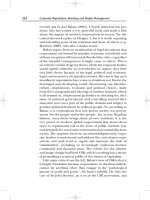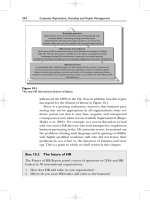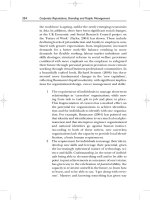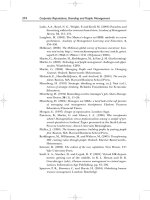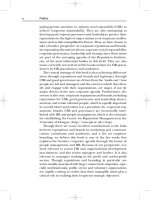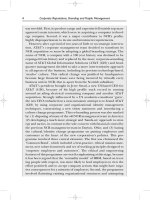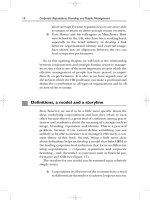Corporate Reputations, Branding and People Management 38
Bạn đang xem bản rút gọn của tài liệu. Xem và tải ngay bản đầy đủ của tài liệu tại đây (112.47 KB, 10 trang )
the workforce is ageing, unlike the newly emerging economies
in Asia. In addition, there have been significant social changes,
as the UK Economic and Social Research Council project on
the ‘Future of Work’ (Taylor, 2004) has shown. These include
declining levels of job satisfaction and loyalty to employers com-
bined with greater expectations from employment; increased
demands for a better work–life balance resulting in more
demands for flexible working; labour market turbulence and
skills shortages; structural reforms in social welfare provisions
combined with more emphasis on the employee to safeguard
their future through personal pension provision; more remote
working through virtual business-professional communities. In
a beautifully crafted book, Richard Sennett (2006) has docu-
mented more fundamental changes in the ‘new capitalism’,
reflecting Baumann’s liquid modernity, with significant implica-
tions for organizational design, career management and skills:
1 The requirement of individuals to manage short-term
relationships in ‘careerless’ organizations, while mov-
ing from task to task, job to job and place to place.
This fragmentation of careers has a marked effect on
the potential for organizations to achieve identifica-
tion and for individuals to identify with one organiza-
tion. For example, Baumann (2004) has pointed out
that identity and identification is very much a local phe-
nomenon and that attempts to engineer organizational
and national identities go against human instinct.
According to both of these writers, new careerless
organizations lack the capacity to provide local identi-
fication, a basic human requirement.
2 The requirement for individuals to manage their talent,
develop new skills and leverage their potential, given
the increasingly ephemeral nature of technology, sci-
ence and skills. Craftsmanship, in the sense of individ-
uals being able to do something well and to be able to
point to past achievements as a measure of one’s status,
has given way to the celebration of potential ability, the
capacity to re-invent oneself in the future, to learn how
to learn, and to be able to say, ‘I get along with every-
one’. Mastery and knowing something has given way
354 Corporate Reputations, Branding and People Management
to transformative potential and knowing little in the
conventional sense of the term.
3 Ensuing from this ephemeral and fragmented nature
of modern working is the requirement for individuals
to learn how to let go of the past as organizations have
less need for their past skills. Such a characteristic is a
rare one among most people who value their achieve-
ments and prior investment in skills they thought they
had banked for future gain and is associated with the
spectre of ‘uselessness’.
Chapter 10 Creating a fit-for-purpose future 355
Questions for HR leadership
■ How is the HR strategy addressing the demands for flexible work-
ing and offering support for work–life balance?
■ How well do you measure employee identification, e.g. psychological
contracts, identity, commitment, internalization, psychological own-
ership and levels of employee engagement, and are these still mean-
ingful ideas in the light of increasingly fragmented and ‘careerless’
organizations?
■ How does your HR strategy address employees’ career aspirations
and needs for craftsmanship, which are often associated with doing
a job well and being regarded for expertise? Or is it aimed purely at
buying in potential and the skills of learning how to learn, without
necessarily being expert in anything?
■ How well does your HR strategy and policy address more remote
and flexible working and the needs of such people to feel a sense of
belongingness and organizational identity?
■ To what extent do HR strategic business partners in your organization
fall into the category of over-celebrating potential in themselves
and under-valuing craftsmanship? (See the discussion on ‘well-
roundedness’ later in this chapter.)
Consumers
This focus on the outside has been one of the themes of this
book. Changing social structures in developed societies is asso-
ciated with fragmentation and segmentation of product and
service markets. Most marketers are familiar with the basic
tenets of geo-demographic neighbourhood classification sys-
tems. People with similar cultural backgrounds, means and
perspectives naturally gravitate towards one another to form
relatively homogeneous communities and identities. Once set-
tled in, people tend to emulate neighbours, adopt similar
social values, tastes and expectations and, most important of
all, share similar patterns of consumer behaviour toward prod-
ucts, services, media and promotions. This behaviour is the
basis for the development of computer-based classification sys-
tems, all of which classify neighbourhoods and their house-
holds into clusters or groups of neighbourhoods, based on
their underlying socio-economic and demographic compos-
ition. We have argued that such variety in product markets is
increasingly reflected in internal labour markets through
workforce segmentation, based on the principle of requisite
variety. This principle, drawn from organic sciences and sys-
tems theory, states that the degree of internal variation in a
system must match the variation in its environment, and is one
that is widely adopted when designing organizations.
We have also documented the increasing importance of
brands in determining consumer purchasing decisions and
organizational reputations for socially responsible behaviour
among consumers, and their willingness to punish firms that
do not match rhetoric and spin with action.
356 Corporate Reputations, Branding and People Management
Questions for HR leadership
■ To what extent does your HR function understand and systemat-
ically use data on geo-demographics and changing consumer pref-
erences and behaviour to inform its HR policies?
■ To what extent is the HR function teamed up with those respon-
sible for marketing and branding to influence key decisions in these
areas?
■ To what extent are staff in HR sufficiently knowledgeable and cred-
ible with colleagues in marketing and branding to be able to con-
tribute to these key decisions on reputation management and
brands?
Internationalization and globalization
For the past three decades, the world economy has been growing
at its fastest, with more countries sharing in that growth than ever
before. For example, between 1980 and 1999, annual world
exports more than trebled, but during the same period, foreign
direct investment (a form of geographical integration) multi-
plied ten times (Whittington, 2000). Trade liberalization in
Europe and Asia, the rise of the Asian economies, outsourcing
and high levels of labour mobility, coupled with the use of the
Internet to span across borders, have all contributed to the rapid
rise in globalization. Peter Berger has helped lead a major inter-
national research project on the theme of globalization, which
does indeed point in the direction of an emerging global
culture heavily American in origin and content, though this is
increasingly challenged by eastern centres such as Tokyo,
Hong Kong, Singapore, Shanghai and Mumbai (Berger and
Huntington, 2002). This emerging culture, according to Berger,
has four faces, based on a ‘world made in English’ as the cultural,
as well as business, lingua franca:
■ the Davos culture, centred on the discussion held by
big business and the World Economic Forum at Davos
in Switzerland, which has led to a form of economic
globalization through the spread of MNEs’ influence
■ the Faculty Club culture, which reflects the impact of
Western intelligentsia and its liberal ideas of environ-
mentalism, feminism, universal ethics, human rights
and multiculturalism; this culture sometimes merges
with the Davos culture but also sits in tension with it
Chapter 10 Creating a fit-for-purpose future 357
■ Does your HR function have the requisite skills to segment the
workforce to reflect/drive consumer segments, and to design dif-
ferent employee value propositions to align staff, existing and
potential, with brand offerings?
■ How does your HR function measure up in its ability to communi-
cate employee value propositions to different employee segments?
■ the McWorld culture, which reflects the impact of
mainly popular Western youth culture, propagated by
the celebrity firms such as McDonald’s, Nike, Disney,
Apple, Google and MTV, and by the universal access
to American-based media such as television and the
Internet, and
■ evangelical Protestantism, which is the re-emergence
of the Protestant ethic in new parts of the world (e.g.
in parts of Latin America, East and South-East Asia, sub-
Saharan Africa), providing a morality highly appropri-
ate for developing economies seeking to become part of
modern capitalism – disciplined, frugal and science-
based, rationally ordered societies.
These trends look set to continue and hold significant chal-
lenges for HR practitioners and for HR strategies. However,
Berger and his colleagues recognize significant localization
and modifications, which shade into a form of hybrid culture.
We also used this term in describing the dominant mode of HR
systems in Sino-foreign joint ventures (Zhang and Martin,
2003). ‘Hybridization’, which involves synthesizing foreign and
native cultural traits, is likely to be the most common form of
adaptation of management practices in the new economies of
China, India and the Arab world.
358 Corporate Reputations, Branding and People Management
Questions for HR leadership
■ How aware are HR leaders of these trends in globalization, local-
ization and hybridization?
■ To what extent are these trends relevant to your organization’s
future and what are you doing to prepare your HR team and the
organization’s leadership to take advantage of these trends? For
example, how are these trends likely to influence branding strategy
and reputation management?
■ What kinds of HR strategies and policies are necessary to reflect/
drive international branding strategy and reputation management?
■ What proportion of current and future leaders will need developing
in international management and leadership development to sup-
port global branding and what are the best ways of developing them?
